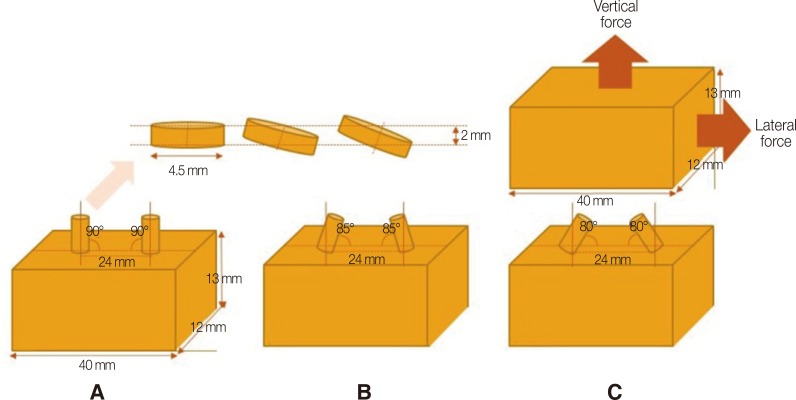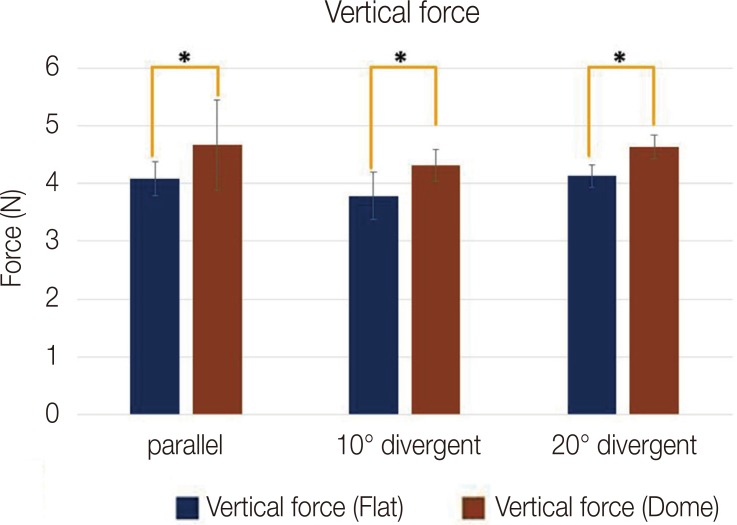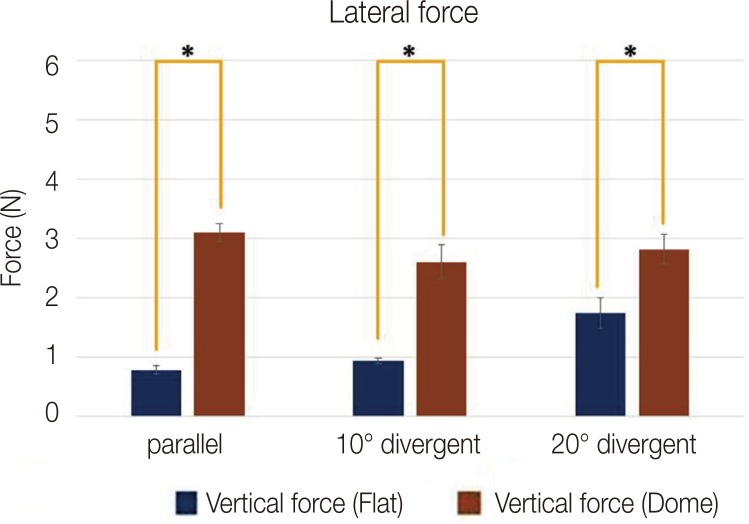Abstract
PURPOSE
The purpose of this study is to evaluate the effects of type of magnet attachment and implant angulation in two implant overdenture models.
MATERIALS AND METHODS
Magnet attachments used in this study were flat and dome types (MGT5515, MGT5520D, Dentium Co., Seoul, Korea). Two implants with keepers were inserted in the resin blocks at a distance of 24 mm. For the first model, the implants were parallel to the vertical and perpendicular to the horizontal; for the second model, both were angulated 5 degrees to the mesial; for the third model, both were angulated 10 degrees toward the mesial. The retentive force was measured in both vertical and lateral directions. Statistical analyses were performed using SPSS software version 22.0 (α=.05).
RESULTS
The flat type magnet attachment showed the highest lateral retentive force in the 20° divergent group (P<.05) and the dome type magnet attachment showed the highest lateral retentive force in the parallel group (P<.05). The vertical and lateral retentive force of the dome type magnet attachment was greater than that of the flat type magnet attachment in every direction (P<.05).
Acquisition of retention and stability in mandibular complete denture remains a challenge for clinicians over a long period of time. Many patients, especially with severely resorbed alveolar ridge, feel uncomfortable with the mandibular complete denture.12 To overcome these problems, mandibular two-implant overdenture is suggested as the first treatment option to the mandibular edentulous patients with the improvement of the quality of life, the increase of the masticatory function, and the comfort of patient with minimal invasiveness.34
An ideal attachment system used in overdenture should provide a stable retentive force not only when the implant is installed in parallel state, but also in inclined state. Furthermore, minimal lateral force must be transmitted to the implants.5
Magnet attachment has the advantages that the fabrication of prostheses is relatively easy even when implants are inclined and the load transmitted to implants is low.6 However, magnet attachment has the disadvantage of low resistance against the lateral force, low magnetic retentive force, no buffering for axial movements, and procedural difficulties.7 To overcome these drawbacks, various types of magnet attachment have been developed. However, few studies have compared retentive force changes at different implant angulations and the shape of the magnet attachment.
Therefore, this in vitro study is aimed to evaluate the effect of implant angulation and types of magnet attachment in two implant overdenture models.
Magnet attachments used in this study were designed for implant overdenture. Flat type magnet attachment (MGT5515, Dentium Co., Seoul, Korea) and dome type magnet attachment (MGT5520D, Dentium Co., Seoul, Korea) with same retentive force of 700 gf were used to avoid the difference in retentive force by attachment. To simulate the clinical situation that the magnet attachment is attached to the denture base and the keeper is connected to the implant fixture, the magnet attachment was attached to the acrylic resin block (40 × 12 × 13 mm, Orthojet, Lang, IL, USA) and the keeper was connected to an implant fixture (FX4510SW, Dentium Co., Seoul, Korea) installed in acrylic resin block. Flat type keeper (MKT5520, Dentium Co., Seoul, Korea) and dome type keeper (MKT6520D, Dentium Co., Seoul, Korea) were used for experiment (Table 1).
In the lower block of the prepared acrylic resin block, two 4.5-mm-diameter holes were formed at a distance of 24 mm.5 For the first model, the holes were parallel to the vertical and perpendicular to the horizontal; for the second model, both were angulated 5 degrees to the mesial; for the third model, both were angulated 10 degrees toward the mesial (Fig. 1). The degree of angulation was determined based on the range that presented the significant change of retentive force in the previous studies and the distance between the holes was set considering the mean distance between the mandibular canines in adults.689
The implant fixture was placed in the block and the keeper was connected with a torque of 25 N according to the manufacturer's instructions. The magnet attachment was placed on the upper side of the keeper and attached to the upper block using self-polymerizing resin (Orthojet, Lang, IL, USA). According to the inclination and types of magnet attachment, six experimental groups were made and ten models were fabricated for each of the six experimental groups. The retentive force was measured in both vertical and lateral directions (Table 2).
The retentive force against the vertical and lateral force to the magnet attachment was evaluated by universal testing machine (AGX-KN10, Shimadzu, Kyoto, Japan). The speed was set to 1 mm/sec in consideration of the speed at which the denture moves in the oral environment during mastication.1011 In order to increase the reliability of the magnet attachment retentive force used in this study, additional experiments were conducted in accordance with the ISO 13017 standard.12
The data was statistically analyzed using the software SPSS 22.0 (SPSS Co., Chicago, IL, USA). One-way analysis of variance was used for statistical analysis, and Tukey's test was used for post-hoc test. All analyses were performed at 95% level of confidence (α = 0.05).
In the flat type magnet attachment, the vertical retentive force of the parallel group was 4.09 N, the 10° divergent group was 3.78 N, and the 20° divergent group was 4.12 N. There was no significant difference in the vertical retentive force according to the implant angulation (Table 3). In the dome type magnet attachment, the vertical retentive force of the parallel group was 4.66 N, the 10° divergent group was 4.32 N, and the 20° divergent group was 4.63 N. There was no significant difference in the vertical retentive force according to the implant inclination (Table 3).
In the flat type magnet attachment, the lateral retentive force of the parallel group was 0.79 N, the 10° divergent group was 0.94 N, and the 20° divergent group was 1.74 N. The flat type magnet attachment showed the highest retentive force in the 20° divergent group (P < .05) (Table 4). In the dome type magnet attachment, the lateral retentive force of the parallel group was 3.10 N, the 10° divergent group was 2.61 N, and the 20° divergent group was 2.81 N. The dome type magnet attachment showed the highest retentive force in the parallel group (P < .05) (Table 4).
Comparing the vertical retentive force according to the type of the magnet attachment, the dome type magnet attachment showed higher retentive force than the flat type magnet attachment, regardless of implant angulation (P < .05) (Fig. 2). The lateral retentive force of the dome type magnet attachment was greater than that of the flat type magnet attachment regardless of implant angulation (P < .05) (Fig. 3).
Using complete denture is challenging because of difficulty in acquiring an acceptable level of prosthesis stability and retention.1314 Implant overdentures are predictable solution to replace complete denture for edentulous mandible. There are many attachment systems for implant overdentures. Magnet attachment is one of the available attachment systems for implant overdentures. However, a weak point of magnet is resistance to lateral force. Implant angulations may also reduce retention. To overcome these drawbacks, various types of magnet attachment, such as flat, cushion, reverse dome, and dome types, have been developed.
In this study, the installation of two implant fixtures in an acrylic resin block simulated a mandibular implant retained overdenture, which was regarded as the first treatment option for completely edentulous patients.415
Concerning the magnetic force, the manufacturer data was 700 gf in both type of magnet attachments, which is approximately 6.86 N. However, in the results of present study model, the vertical forces on both type magnet attachments were 4.09 N and 4.66 N. They were lower than the manufacturer data. In the effect of implant angulation, there was no significant difference in the vertical retentive force according to the implant inclination in each attachment group. It is different from the study of Rabbani et al.,9 in which the locator attachment system with different angulations showed significant different retentive forces between parallel and 10° divergent groups. It might be inferred from our results that magnet attachment is relatively less influenced by the angulation for implants, regardless of attachment types. This result was in agreement with a previous study.6
Considering the morphology of the magnet attachments, the resistance to vertical and lateral force is shown to be significantly higher in the dome type than in the flat type, regardless of the implant angulation (P < .05). Yang et al.8 compared the flat type magnet attachment and self-adjusting magnet attachment, and reported that the flat type magnet attachment showed significantly higher lateral retentive force at 15°, 30°, and 45°group. In the study of Lee et al.16 comparing the flat type magnet attachment with cushion type magnet attachment, cushion type of magnet attachment was found to be less retentive in oblique direction of dislodging force compared to flat type (P < .05). However, in this study, vertical and lateral retentive force of the dome type magnet attachment was greater than that of the flat type magnet attachment in every angulation. It can be suggested that the dome type magnet attachment has an acceptable resistance to the lateral force in angulated implants.
In the lateral retentive force test, the 20° divergent group of the flat type attachment showed a higher lateral retentive force compared to the other inclination groups (P < .05), while all the groups have shown the force less than 2 N. In the dome type attachment, there was no significant difference among the different angulation groups (P > .05) and significantly higher than all flat groups (P < .05). It seems the concave morphology of the dome type attachment could be effective when lateral force was applied in angulated implant case, being suitable for the purpose as it designed. In this study, not considering the incursion or excursion and the rotation movements to the applied lateral force, it was conducted at the constant state of the experimental environment different from the oral environment. A further study including more variables is needed.
References
1. Moghadam BK, Scandrett FR. Magnetic retention for overdentures. J Prosthet Dent. 1979; 41:26–29. PMID: 364035.

2. Gillings BR. Magnetic retention for overdentures. Part II. J Prosthet Dent. 1983; 49:607–618. PMID: 6343587.

3. Feine JS, Carlsson GE, Awad MA, Chehade A, Duncan WJ, Gizani S, Head T, Lund JP, MacEntee M, Mericske-Stern R, Mojon P, Morais J, Naert I, Payne AG, Penrod J, Stoker GT Jr, Tawse-Smith A, Taylor TD, Thomason JM, Thomson WM, Wismeijer D. The McGill Consensus Statement on Overdentures. Montreal, Quebec, Canada. May 24-25, 2002. Int J Prosthodont. 2002; 15:413–414. PMID: 12170858.
4. Thomason JM, Feine J, Exley C, Moynihan P, Müller F, Naert I, Ellis JS, Barclay C, Butterworth C, Scott B, Lynch C, Stewardson D, Smith P, Welfare R, Hyde P, McAndrew R, Fenlon M, Barclay S, Barker D. Mandibular two implant-supported overdentures as the first choice standard of care for edentulous patients-the York Consensus Statement. Br Dent J. 2009; 207:185–186. PMID: 19696851.
5. Takeshita S, Kanazawa M, Minakuchi S. Stress analysis of mandibular two-implant overdenture with different attachment systems. Dent Mater J. 2011; 30:928–934. PMID: 22123019.

6. Chopra V, Smith BJ, Preiskel HW, Palmer RM, Curtis R. Breakaway forces of flat and domed surfaced Magfit implant magnet attachments. Eur J Prosthodont Restor Dent. 2007; 15:7–12. PMID: 17378452.
7. Riley MA, Walmsley AD, Harris IR. Magnets in prosthetic dentistry. J Prosthet Dent. 2001; 86:137–142. PMID: 11514799.

8. Yang TC, Maeda Y, Gonda T, Kotecha S. Attachment systems for implant overdenture: influence of implant inclination on retentive and lateral forces. Clin Oral Implants Res. 2011; 22:1315–1319. PMID: 21426402.

9. Rabbani S, Juszczyk AS, Clark RK, Radford DR. Investigation of retentive force reduction and wear of the locator attachment system with different implant angulations. Int J Oral Maxillofac Implants. 2015; 30:556–563. PMID: 25671627.

10. Boeckler AF, Morton D, Ehring C, Setz JM. Mechanical properties of magnetic attachments for removable prostheses on teeth and implants. J Prosthodont. 2008; 17:608–615. PMID: 18761583.

11. Uludag B, Polat S, Sahin V, Çomut AA. Effects of implant angulations and attachment configurations on the retentive forces of locator attachment-retained overdentures. Int J Oral Maxillofac Implants. 2014; 29:1053–1057. PMID: 25216129.

12. ISO 13017:2012/AMD 1:2015. Dentistry - Magnetic attachments - Amendant 1. Geneva; Switzerland: International Standards Organization (ISO);2015. Accessed November, 2015. Available at: https://www.iso.org/standard/63938.html.
13. Lahori M, Kaul AS, Chandra S, Nagrath R, Gupta H. Comparative evaluation of bone in mandibular implant retained overdentures using delayed and immediate loading protocol: an in-vivo study. J Indian Prosthodont Soc. 2013; 13:113–121. PMID: 24431720.

14. Cristache CM, Muntianu LA, Burlibasa M, Didilescu AC. Five-year clinical trial using three attachment systems for implant overdentures. Clin Oral Implants Res. 2014; 25:e171–e178. PMID: 23278517.

15. Koole S, De Bruyn H. Contemporary undergraduate implant dentistry education: a systematic review. Eur J Dent Educ. 2014; 18:11–23. PMID: 24484516.

16. Lee E, Shin SY. The influence of the number and the type of magnetic attachment on the retention of mandibular mini implant overdenture. J Adv Prosthodont. 2017; 9:14–21. PMID: 28243387.

Table 1
List of magnet attachments and implant fixture

Table 2
The design of experimental group

Table 3
Retentive force of magnet attachments in vertical direction





 PDF
PDF ePub
ePub Citation
Citation Print
Print







 XML Download
XML Download